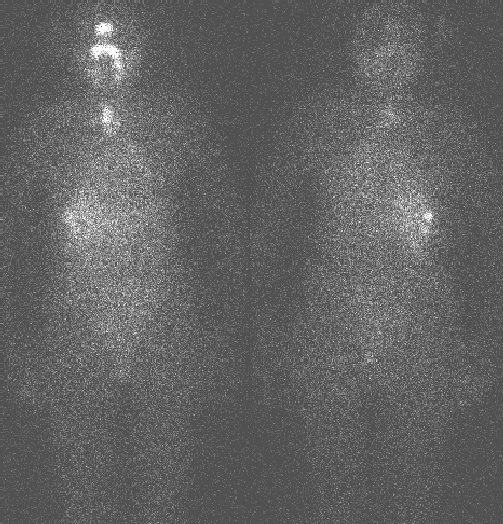Case Author(s): Gabriel De Simon, M.D. and Keith Fischer, M.D. , 12/28/00 . Rating: #D3, #Q4
Diagnosis: Metastatic poorly differentiated thyroid cancer.
Brief history:
Thyroid cancer with total thyroidectomy in December 1998.
Images:

Anterior and posterior whole body images.
View main image(tr) in a separate image viewer
View second image(tr).
Anterior, RAO and LAO images of the neck.
View third image(xr).
Postero-anterior chest radiograph.
View fourth image(xr).
Lateral chest radiograph.
Full history/Diagnosis is available below
Diagnosis: Metastatic poorly differentiated thyroid cancer.
Full history:
Seventy-five year old female who had a total thyroidectomy in December 1998, with histology demonstrating a poorly differentiated insular subtype thyroid cancer, with coexistent regions suspicious for medullary cancer. She subsequently received an ablative dose of Iodine 131, and after a disease-free interval of approximately two years, represented with palpable nodularity in the thyroid bed and enlarged cervical lymph nodes. The patient is status-post a 150 mCi Iodine 131 ablative treatment dose five days before the main imaging study.
Radiopharmaceutical:
150 mCi therapeutic dose of Iodine 131, 120 hours before the whole body images.
Findings:
IODINE 131 IMAGES:
1. Moderately intense, increased activity in the right thyroid bed, with a small, second focus of increased activity in the inferior left thyroid bed.
2. Bilateral, diffusely increased pulmonary activity, with a small, more intense focus of increased uptake peripherally in the right pulmonary base.
3. Mildly increased hepatic activity.
CHEST RADIOGRAPH:
1. Multiple pulmonary nodules of varying sizes in a predominantly basal distribution, consistent with pulmonary metastases.
Discussion:
Carcinoma of the thyroid gland is an uncommon cancer, but is the most common malignancy of the endocrine system, with about 12,500 new cases annually in the U.S. It affects more women than men, the majority occurring between the ages of 25 and 65 years. Differentiated tumors(papillary or follicular) are treatable and usually curable. Poorly differentiated(medullary and anaplastic) cancers are less common but are aggressive, metastasize early and generally have a much poorer prognosis. This patient had several adverse risk factors at presentation, including poorly differentiated histology, primary size greater than 4.5 cm, and age more than 45 years. Undifferentiated tumors constitute an increasing proportion of lesions in each decade subsequent to the fifth. There is pathologic evidence that tumors arise, in about 50% of cases, in long-standing benign lesions or in differentiated carcinoma. The "insular" subtype of undifferentiated cancer was identified in this patient, a subset of carcinoma which gives the histologic picture of "islands of cells", and unlike anaplastic cancers, are sometimes able to concentrate Iodine 131, making them amenable to this form of treatment. After a disease-free interval of about two years, the patient re-presented with difficulty in swallowing, palpable nodules in the thyroid bed, and an elevated serum thyroglobulin level, consistent with local recurrent or metastatic disease. Recurrent palpable disease in the neck(thyroid bed or lymph nodes), is usually treated by surgical excision, which may include resection of all infiltrated local tissues and even part of the airway. The patient underwent a central and lateral neck dissection, with histology showing recurrent carcinoma, and subsequently also received two ablative doses of Iodine 131. A whole body FDG PET scan performed after this, was negative for residual disease or metastases. Due to persistently elevated thyroglobulin levels however, a third 150 mCi Iodine 131 treatment dose was administered, and the scan performed five days after this dose demonstrates residual disease in the thyroid bed and diffuse pulmonary activity, consistent with innumerable tiny metastases, confirmed radiographically. A small focus of moderately increased activity projecting over the right lung base does not correlate radiographically to the presence of a lung metatasis, and may therefore represent either a rib metastasis( uncommon in undifferentiated cancers), or a hepatic metastasis. The diffusely increased liver activity on the I 131 scan is explicable by enhanced thyroglobulin and bound iodine removal from the circulation by the liver, with resultant free hepatic iodine. Diffuse pulmonary metastases are typically treated with 200mCi Iodine 131, although those concentrating more than 50% of the diagnostic dose may be treated with a reduced dose to avoid lung injury. Older patients in high risk categories who have minimally iodophilic metastases, are sometimes treated with doses as high as 300 mCi. Administration of supraphysiological oral doses of levothyroxine has been widely used, based on the assumption that suppression of endogenous TSH production deprives neoplastic cells of an important growth-promoting influence. The goal of thyroxine therapy has been the complete suppression of pituitary TSH secretion. External beam radiation may also be beneficial in poorly-differentiated tumors not concentrating radioiodine.
Followup:
Long term follow-up of this patient will include targeted imaging aimed at detecting recurrence in the neck, including high frequency ultrasound, high resolution CT and MRI, and whole body Iodine 131 scans.
Increased thyroglobulin levels are continued useful indicators of the presence of metastatic disease. Due to thyroglobulin suppression by thyroxine administration in some patients, the thyroglobulin level should be measured after stopping the thyroxine, with the patient hypothyroid. Thyroglobulin assays are invalidated by the presence of thyroglobulin autoantibodies, and all samples must therefore be screened.
ACR Codes and Keywords:
References and General Discussion of Thyroid Scintigraphy (Anatomic field:Face, Mastoids, and Neck, Category:Neoplasm, Neoplastic-like condition)
Search for similar cases.
Edit this case
Add comments about this case
Return to the Teaching File home page.
Case number: tr011
Copyright by Wash U MO

